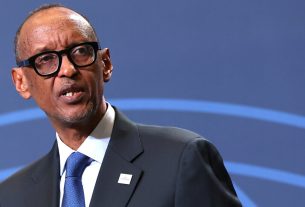Brice Makinadjian and Stephane Deport, both engineers at Airbus Helicopters, looked on proudly as a sleek blue-and-white helicopter zipped over the crowds at the Paris Airshow in June 2025.
Slicing through the air was the Airbus RACER (Rapid and Cost-Effective Rotorcraft), an advanced prototype designed to be faster, quieter and more fuel-efficient than conventional helicopters.
This high-speed, low-emission rotorcraft is redefining helicopter flight by blending the speed of an aeroplane with the agility of a rotorcraft – all while slashing CO2 emissions by approximately 25% compared to a conventional helicopter of the same weight category.
How it started: a European team effort
The RACER’s roots go back to the EU’s Clean Sky 2 programme (2014–2024), the largest research programme for aviation ever launched in Europe.
This public-private collaboration between the European Commission and the European aeronautics industry funded the development of innovative, cutting-edge technologies to reduce the aeronautics sector’s environmental impact.
“
We could not have done this without European collaboration and support.
The support provided under Clean Sky 2 made it possible for the various components of the RACER – such as aerodynamics, engine integration and rotor systems – to be incrementally refined before being tested together in the demonstrator built by Airbus, a leading European aerospace company.
“This partnership has been fundamental,” said Makinadjian. “We could not have done this without European collaboration and support.”
The development of the prototype has involved over 40 European companies and research organisations from 13 countries. “We have access to the best of Europe,” said Makinadjian. “It is the European spirit at its finest.”
Cleaner future for European skies
The RACER is also part of Europe’s mission to make flying greener. Under the European Green Deal, the EU has pledged to become climate neutral by 2050, and aviation is no exception.
The EU’s Sustainable and Smart Mobility Strategy sets the goal of having zero-emission aircraft ready for market by 2035. This would mark a major step toward climate-neutral aviation and a cleaner future for European skies.
Why does this matter? As Axel Krein, executive director at the Clean Aviation Joint Undertaking (2025–2035) – Clean Sky 2’s successor – pointed out, aviation is a powerhouse for Europe’s economy. It supports 13.5 million jobs and contributes over €1 trillion to the European economy. That is 3.6% of all jobs and 4.4% of Europe’s GDP.
For Krein, the importance of the RACER demonstrator for Europe is evident. Such new designs will help secure Europe’s aerospace leadership in the future.
“Currently, Europe has a market share of 58% of new civil aircraft worldwide, so Europe’s aviation leadership is strong. But it is not guaranteed,” he said. “Global competition and geopolitical shifts are threatening this leadership.”
Stealth and speed
After over 10 years in development, the new technologies being showcased in the RACER prototype could become an essential part of helicopter design over the coming decade.
The RACER’s sleek aerodynamic design and side-mounted lateral rotors give it a cruising speed of over 440 km/h – over 50% faster than regular helicopters.
One of the factors is the reduced air and wind resistance, or drag, as it moves through the air. This is 2.5 times lower than in other helicopters of the same weight.
“We have a lower drag than the smallest helicopters on the market today,” said Makinadjian.
The main rotor was redesigned, reducing its speed, to increase stability. At the same time, two wings were added at the sides with lateral rotors to provide forward thrust.
This means that the RACER can fly like an aeroplane in certain flight phases, using its wings and lateral rotors to glide forward, making it effectively a cross between a helicopter and a fixed-wing aircraft.
Eco-mode
The innovative Eco Mode system is another standout feature, similar to the start-stop function in modern cars, that will soon be tested on the RACER. Developed by Safran, the Eco Mode involves putting one of the two engines on standby during cruise flight, allowing the other to operate at a more optimal and energy-efficient power setting.
This mode of operation not only reduces CO₂ emissions and fuel consumption by around 15%, but also increases the distance that can be covered by the helicopter.
“We can fly at 350 km/h on only one engine,” said Deport. “But we also need to be able to restart the other engine instantly to keep it safe.”
Overall, the improved aerodynamics and innovative design allow the RACER to use 25% less fuel than slower, conventional helicopters. As the team gears up to begin testing the Eco Mode feature, they expect to achieve even more fuel savings.
In addition to commercial transport, the developers predict that the RACER could be ideal for emergency medical services and search and rescue operations because of its speed and efficiency.
“Emergency response helicopters need to be fast and noise reduction is key to perform operations close to inhabited areas,” said Makinadjian.
From cars to choppers
A total of 40 partners collaborated on the creation of the RACER. One unexpected partner in the RACER’s journey was KLK Motorsport, an SME from Germany specialised in high-performance mechanical engineering, lightweight structures and advanced composite materials.
“
Europe’s aviation leadership is strong. But it is not guaranteed.
Better known for its expertise in car racing rather than aerospace, KLK co-developed the RACER’s canopy – the sleek, enclosure over the cockpit that needs to handle airflow efficiently to optimise aerodynamics.
Their involvement highlights one of the RACER’s greatest strengths: the wide collaboration that went into its development, which brought in the expertise of major industry players, but also specialised SMEs and leading research organisations.
“Working with people outside aerospace is invigorating,” said Makinadjian. “The creation of new parts for car racing moves at lightning speed. When we told them they had five years to develop a “very innovative and light” canopy, they were surprised,” he laughed. “In racing, everything needs to be delivered yesterday.”
Flying into the future
The RACER prototype took to the skies for the first time in April 2024. More than a year on, it has logged around 35 hours of flight time, but there is plenty more testing ahead.
Despite their deep involvement in the design, engineers Makinadjian and Deport have yet to fly in the RACER themselves. “Only eight people, besides the test pilots, have been able to,” said Makinadjian. “We’re still on the waiting list.”
Tests continue at the Airbus Helicopters’ headquarters in Marignane, near Marseille in southern France. Early results are encouraging. But Makinadjian and Deport are still working hard to finetune the technical details. For them, this is just the start.
What excites them most is simply being part of the journey. “If you’re an aerospace engineer, this kind of project only comes along once in a lifetime,” said Makinadjian. “To go from nothing to seeing your design take flight – it’s magical.”
As the RACER continues its test flights, it is not just pushing the boundaries of rotorcraft speed – it is charting the course for a new era of more fuel-efficient, smarter aviation in Europe.
Research in this article was funded by the EU’s Horizon Programme. The views of the interviewees don’t necessarily reflect those of the European Commission. If you liked this article, please consider sharing it on social media.



